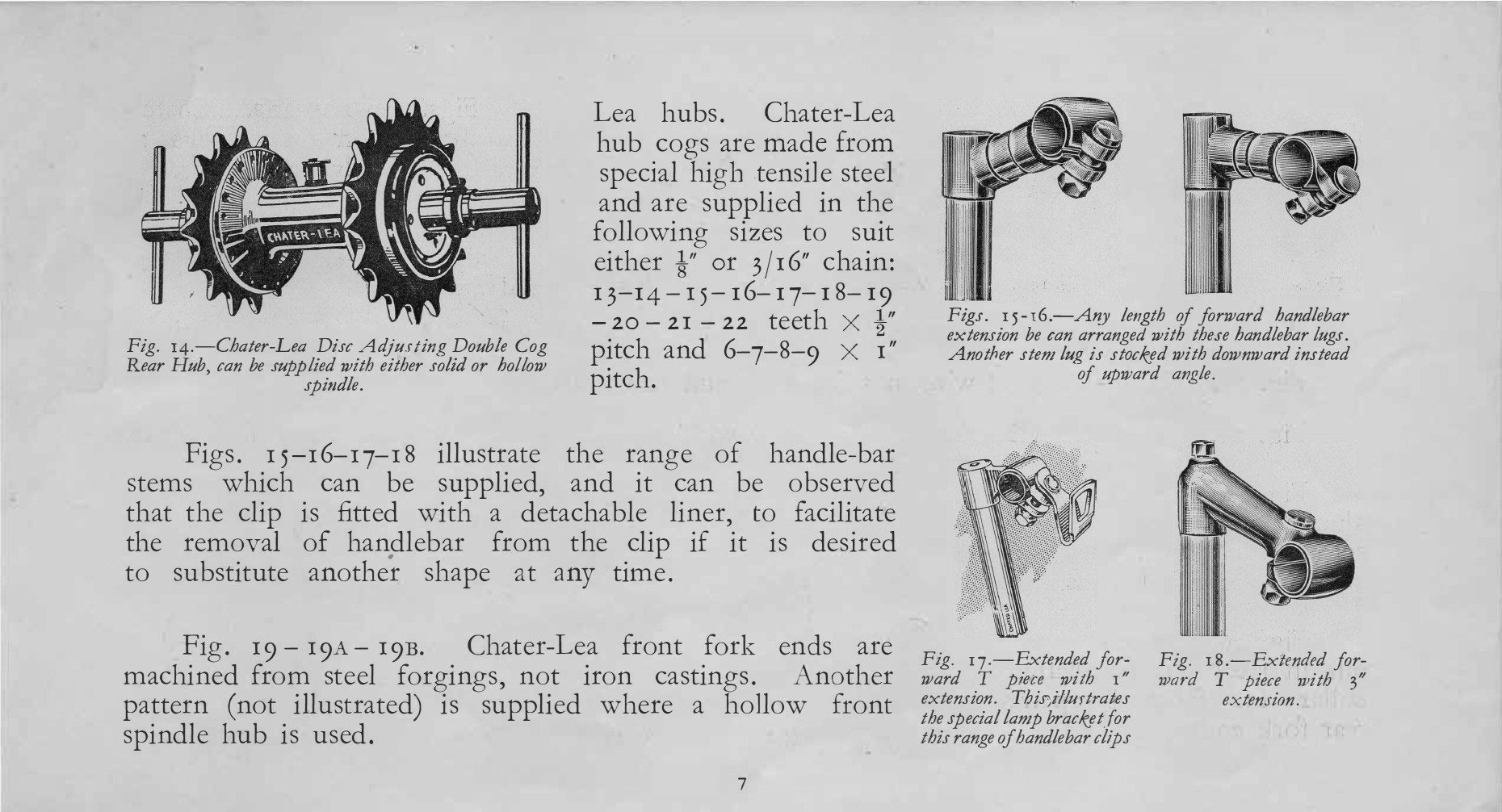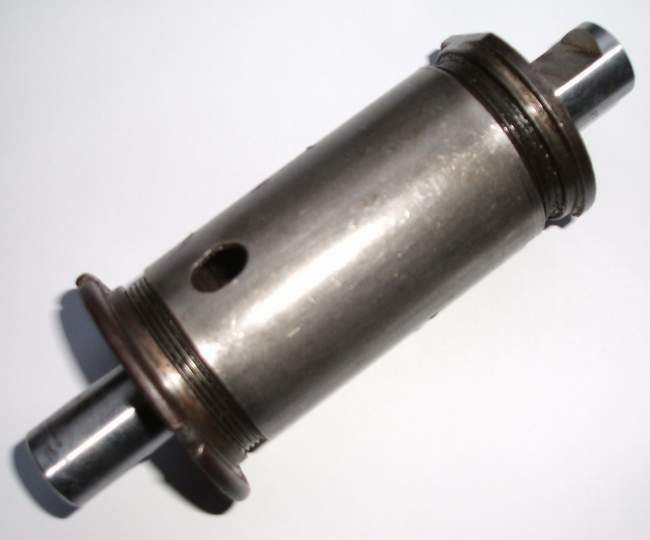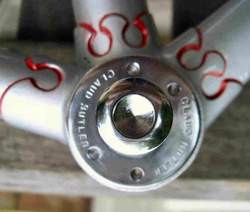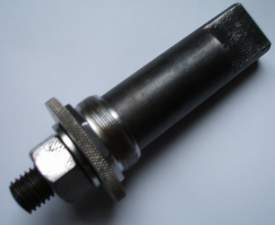Bottom brackets - Chater-Lea and others
Posted: Thursday 11th June 2020
Chater-Lea produced two sizes of post-war bottom-brackets, known here in the UK as 1/4 and 5/16”. The oversize models were used by some builders such as Saxon, Claud Butler and Carlton for solo machines and they were commonly used on tandems.
1/4” (ball size) Bottom Bracket
The fixed cup is No. 1616, the adjustable cup No. 1617 with lockring No. 1618
The cups are 1.37″ diameter.
There are three different axle lengths listed in 1952:
Single No. 1007, double No. 1240 /1 and the intermediate No. 1240
Aids to Happy Cycling 1951 states:
Chater-Lea Axles to give a 1½” chain line –
No. 1007 for single fixed
No. 1240 for double chainwheel
Checking my axles, three are No. 1615 which number runs with the ¼” series above, they are 120mm in length
5/16” (ball size) BB
Axles are not interchangeable with ¼.
The fixed cup is No 1350 and the adjustable cup No. 1349 with lockring No. 1380
The cups are 1.45” diameter.
Baylis Wiley, TDC, Brampton and BSA were also suppliers of bottom bracket sets, the first two also produced an integral BB unit, Bayliss-Wiley called theirs the ‘BW’ Patent Oil Bath Unit. In Cycling, 1931 Bayliss-Wiley announced the introduction of their Patent Oil-bath BB Unit. If you come across a 40s/50s frame with no threads in the bottom bracket, for example some Paris and R O Harrison frames, then this unit is what you need. The units are based on a cylinder/barrel which slides into the BB. The insides of this are threaded and the bearing cups which thread in on either side have a shoulder which locks onto the ends of the BB. The frame BB shell may well have a hole drilled to take a retaining bolt which screws into the barrel, this locates the BB unit and stops inadvertent turning.
Bottom bracket axle BW (Baylis Wiley) 14 was for double and BW 15 for single chainsets. Some bottom-bracket shells for the serious collector. A pair of the genuine ‘Claud Butler’ cups and lockring on this early Claud Butler Anglo-Continental frame.
One of the bugbears of bottom brackets is the fixed cup which can be next to impossible to release. Here in the UK there is a Jackson tool which bolts onto the cup, with a washer underneath, and the nut is tightened with a long spanner (for purchase). As the nut tightens it will release the cup with its left-hand thread. The tighter the cup is then the more pressure is put on by the nut. Now you need to get the cup off the tool but there are flats on the opposite end to lock the assembly in a vice and so be able to release the nut, washer and cup. I also use the tool for putting this cup in. I secure the flats in the vice and tighten the nut over the cup. If there is too much resistance then the whole thing will undo. Time to clean out the threads. Which reminds me, ask your resprayer to clean the threads if you don’t have a tool with which to do this. Even a very small amount of paint can cause severe problems.
See also ‘Bottom Bracket Lengths‘ by Steve Griffith
Years ago (1977?) with limited budget and 5/16” Chater parts in an apparent limited supply I converted a tandem to 1.37” solo axles using sleeves then available from the Tandem Club. I don’t know who made the tandem but it was bought from ex-clubmate Colin Warren, who was working as a gas fitter in the conversion of Bethnal Green Fire station to a Buddhist retreat. This first tandem passed to another Redbridge CC member and since 1982 we have owned a 1939 Claud Butler with Chater brackets, headset, chainsets and pedals. I have a post war 2 arm chainset and bracket on a solo too.
I spotted first that you mentioned using three 1615 axles (in solo’s I assume) but in your preceding lines you had not mentioned the part. I have a 1931 Chater catalogue and I looked there first and later some Holdsworth ‘Aids’, finding some variation in the part numbers you quoted.
Part numbers from 1931 Chater Lea Catalogue
Solo cycle parts using 5/16” balls:
| Axle | 1007 |
| Fixed cup | 1350 |
| Adjusting cup | 1349 |
| Lockring | 380 |
Tandem parts using 5/16” balls and front eccentric bottom bracket:
| No. 12B and 15A tandem (In-line drive?) | No. 14 Tandem (Crossover drive) |
|
| Axle | 805 | 1240 |
| Fixed cup | 1200 (L H thread) | 396 (R H thread) |
| Adjusting cup | 1349 (R H thread) | 397 (L H thread) |
| Lock ring | 380 (R H thread) | 395 (L H thread) |
Rear bottom bracket:
| No 12B and 15A Tandem 1 ¾” chainline (In-line drive?) | No 14 Tandem 11/2” chainline (Crossover drive) | |
| Axle | 802 | 1240 |
From Holdsworth’s ‘Aids to Happy Cycling’ between 1936 and 1955:
| 1936/9 | show only the number for a tandem spindle 1007 |
| 1949 | No numbers found |
| 1951 | 1007 for 1½" chainline 1240 for double chainwheel |
| 1952 | Describes parts as 1½” chainline for ¼” balls or 5/16” balls (although the sizes are clearly not interchangeable) use either axle No. 1007 or 1240 for a double chainwheel. |
| 1953 | As shown for 1952 |
| 1954 | Axles 1½” chainline for ¼” balls (No. 1615) or for 5/16” balls (No. 1007). Axle No. 1240/1 for a double chainwheel. |
| 1955 | As shown for 1954 |
So without sight of any further information, I wonder if 1007 and 1240 axles were offered initially for only 5/16” balls and 1.45″ cups? Later when ¼” balls and 1.37″ cups were introduced to Chater Lea for solo’s, were the same part numbers used for either size standard chosen by the buyer? Later still when sales volumes increased perhaps, was 1007 used only for 5/16″ balls and 1615 added to denote ¼” balls? Perhaps 1240 was retained for 5/16″ balls and 1240/1 introduced for ¼” balls and double chainwheel?
Posted: Thursday 11th June 2020
This article appears in the following categories.
Upcoming Events
Whether you are looking for a gentle social meet up, or a 100-mile ride browse the community’s upcoming events and plan your next weekend outing.



